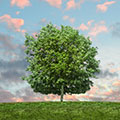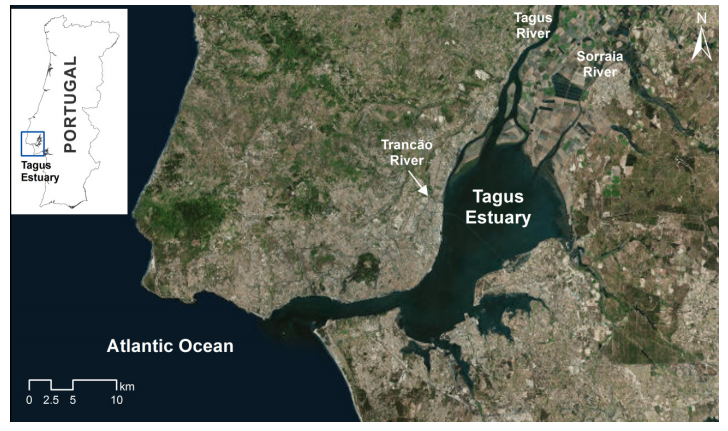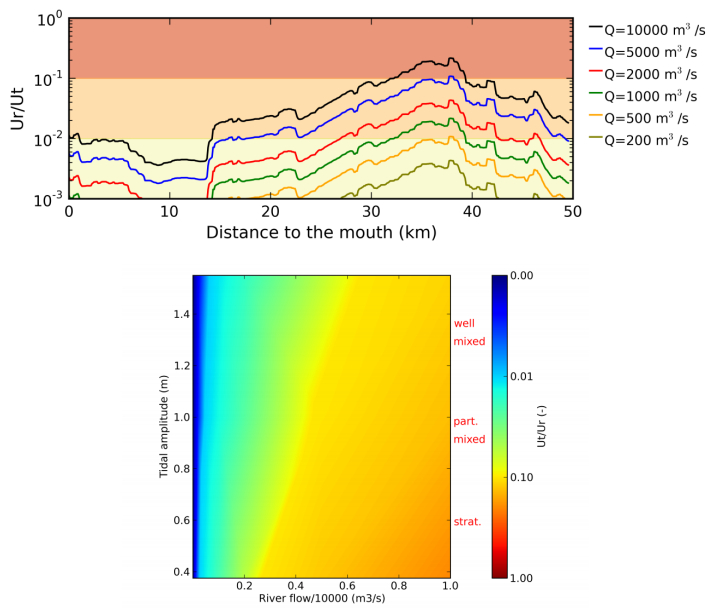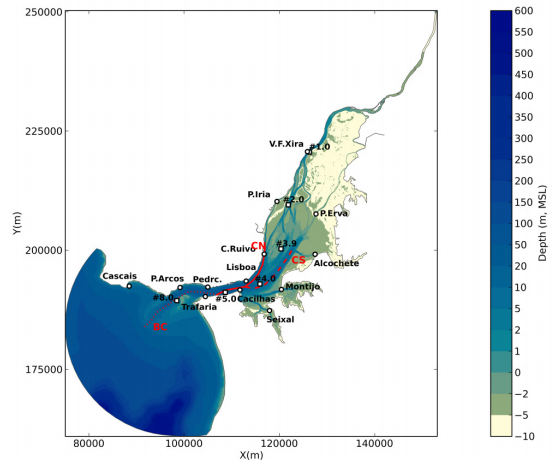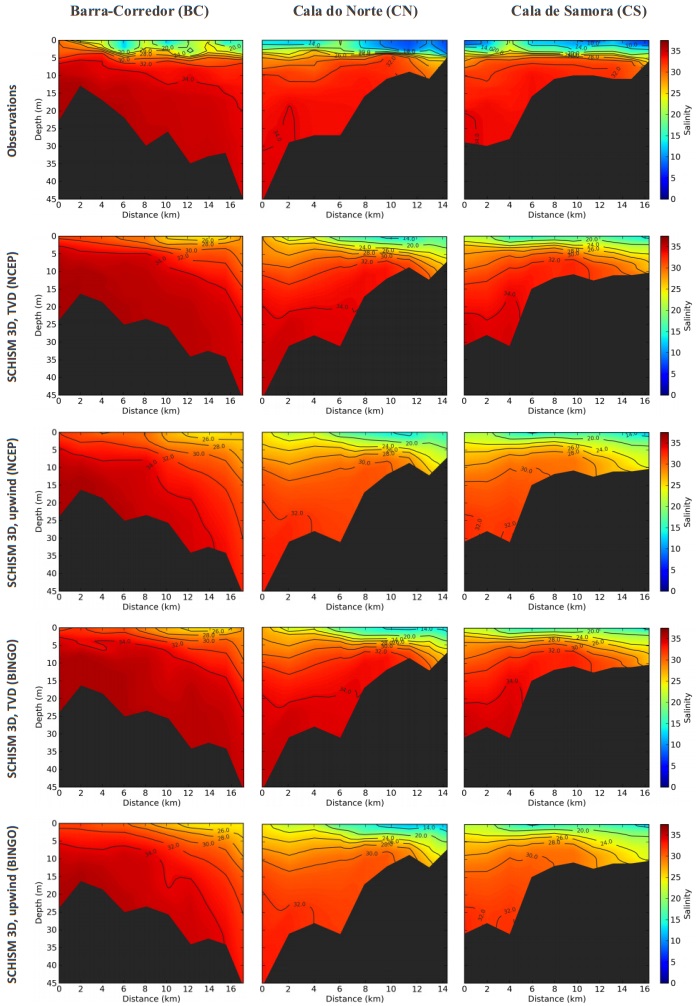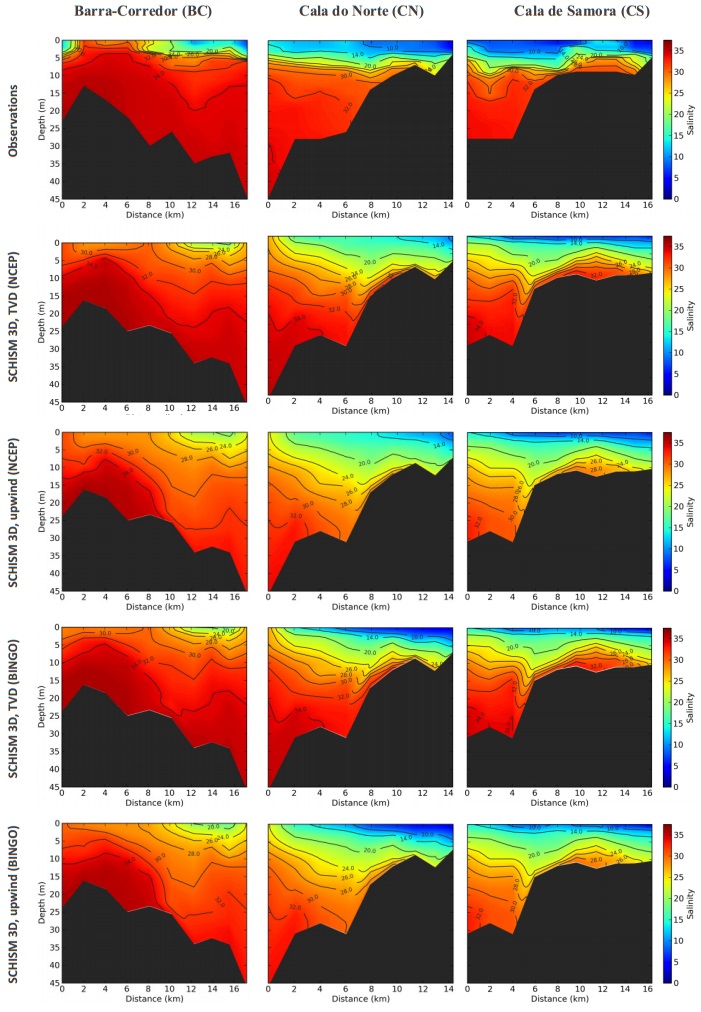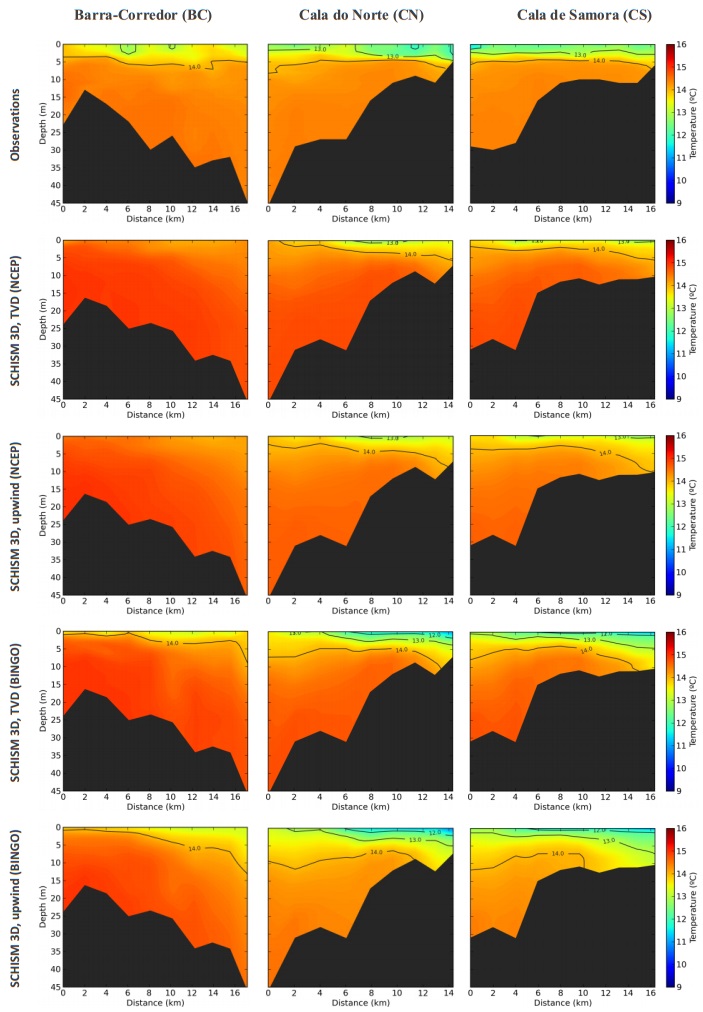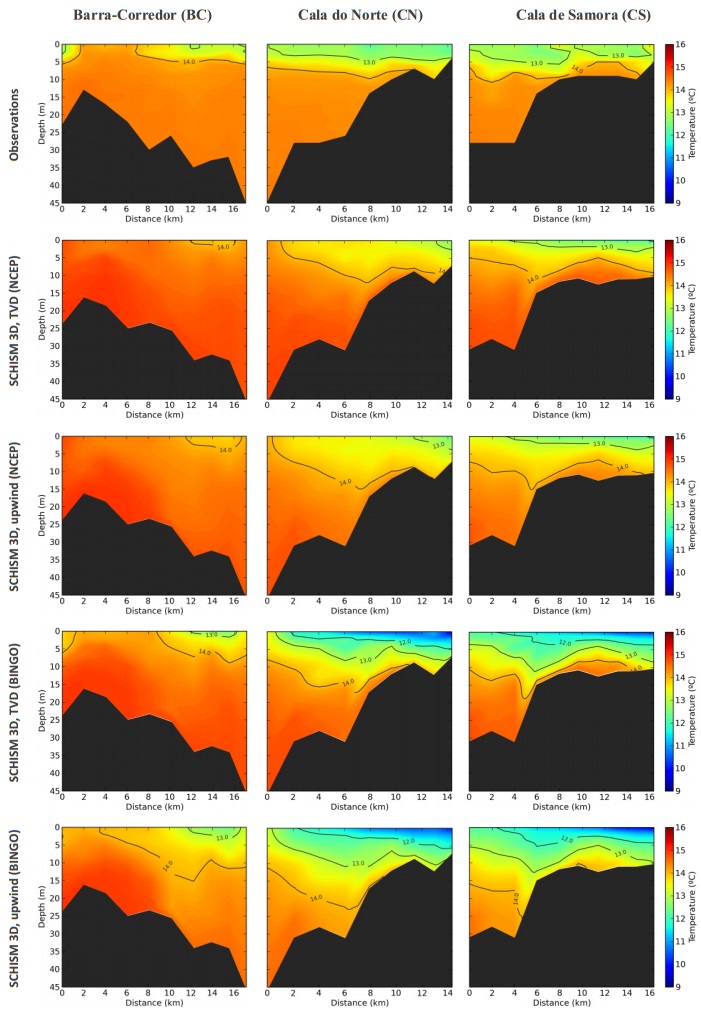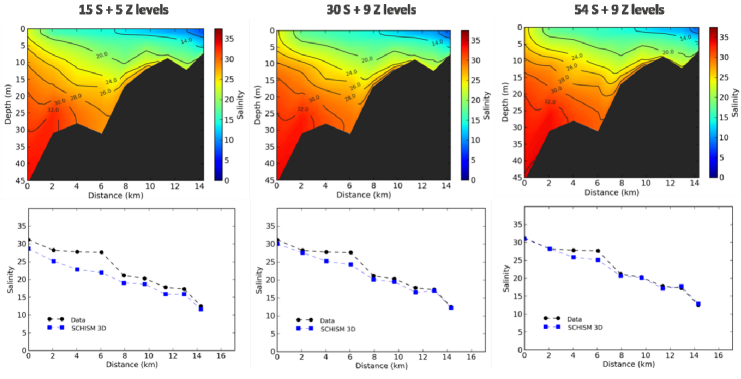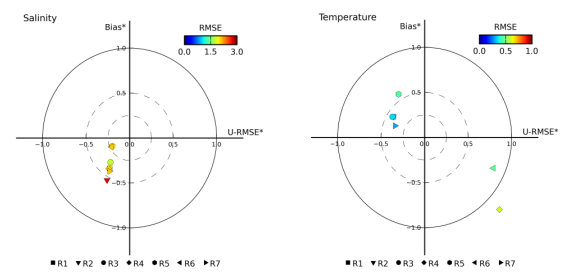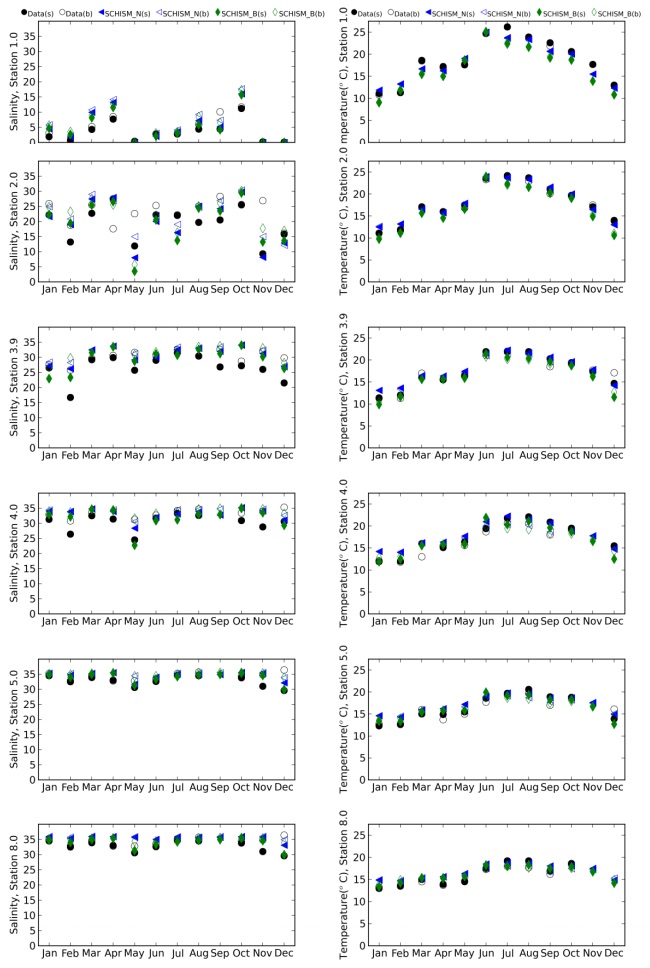Circulation patterns and physical regimes play a major role in estuarine ecosystems. Understanding how different drivers, like climate change, may affect the estuarine dynamics is thus fundamental to guarantee the preservation of the ecological and economical values of these areas. The Tagus estuary (Portugal) supports diverse uses and activities, some of which may be negatively affected by changes in the hydrodynamics and salinity dynamics. Numerical models have been widely used in this estuary to support its management. However, a detailed understanding of the three-dimensional estuarine circulation is still needed. In this study, a three-dimensional hydrodynamic baroclinic model was implemented and assessed using the modeling system SCHISM. The model assessment was performed for contrasting conditions in order to evaluate the robustness of the parametrization. Results show the ability of the model to represent the main salinity and water temperature patterns in the Tagus estuary, including the horizontal and vertical gradients under different environmental conditions and, in particular, river discharges. The model setup, in particular the vertical grid resolution and the advection scheme, affects the model ability to reproduce the vertical stratification. The TVD numerical scheme offers the best representation of the stratification under high river discharges. A classification of the Tagus estuary based on the Venice system regarding the salinity distribution for extreme river discharges indicates a significant upstream progression of the salt water during drought periods, which may affect some of the activities in the upper estuary (e.g., agriculture). The model developed herein will be used in further studies on the effects of climate change on the physical and ecological dynamics of the Tagus estuary.
1.
Introduction
A soliton is considered a wave packet with a localized form that can maintain its form and velocity through a nonlinear transferring media when the nonlinearity and the dispersion of that soliton are precisely exact balanced [1]. Solitons are important experimentally, in either practical or theoretical studies, due to their robust properties and unique nature, which appear in their dynamic propagation and interactions [2,3]. Numerous scientific studies have been carried out on soliton formation due to their essential dynamical processes [4,5,6,7,8]. These studies display the main concepts of solitons and many of their aspects, especially in optical field, including their models, dynamic features, and nonlinear effects. Many researchers have studied optical solitons to utilize their unique characteristics in technology development. These studies have focused on the contribution of nonlinear solitons in photonics research. In [9,10,11], the phase imprinting method was used with Bose-Einstein condensates (BECs) to generate dark solitons. In [12], Feshbach resonance was used to produce bright matter-wave solitons, converting interactions from repulsion to attraction. Beyond dark and bright solitons, other types of solitons have been studied and generated, such as vortex solitons and surface gap solitons in [13]. The soliton waves are governed through the BECs by the used Gross-Pitaevskii (GP) model, which comes from mean field theory [14]. In [15], an investigation was implemented to obtain bidirectional wave solutions for a newly created two-mode extension of the coupled Korteweg-De Vries (KdV)-Schrödinger equations. Theoretically, aside from the second-order diffraction/dispersion and cubic nonlinearity factors, the nonlinear Schrödinger equation (NLSE) including the parity-time (PT)-symmetric potential mostly describes the dynamics of PT solitons [16]. Many researchers have applied novel and new methods in order to be able to obtain newly created soliton solutions and many other exact solutions, such as the improved modified extended tanh function method [17], the modified extended mapping method [7,18], the extended Fan sub-equation method [19], the F-expansion method [20], and many others [21,22,23].
In this work, the modified extended direct algebraic method (MEDAM) is applied to a higher-order nonlinearity Schrödinger equation that was used as GP equation in [15,24] but with constant coefficients, as in the following Eq (1.1):
where the function Φ(x,t) denotes the macroscopic wave, the two variables x relate to space, and t relates to time. b represents the velocity dispersion coefficient constant, and ϑ3, ϑ7, and ϑ9 are the respective real nonlinear constant coefficients. νg represents the group delay coefficient constant, while V denotes the complex PT-symmetric potential constant coefficient. The proposed combination between the used model and the applied MEDAM is discussed for the first time in this study, and it offers a variety of options compared to prior approaches, making it unique. Thus, this study solves the highly dispersive solitons, making them very useful for obtaining different soliton waves with different features. It is a noteworthy addition to the field as it discovers creative traveling wave solutions for the proposed model. The model, which is regarded as a GP equation with constant coefficients, describes the propagation of waves in a higher-order nonlinear BEC system. Compared to earlier research, which mainly concentrated on lower-order nonlinearities, the current work significantly advances the nonlinear Schrödinger equation by including cubic, quintic, septic, and nonic nonlinearities. The authors present new stability regimes and dynamic behaviors not before documented by contrasting their unique solutions with those discovered in the literature. This study differs from previous ones in that it presents novel analysis for managing the complexity of higher-order terms. In addition, we investigated the modulation instability for the suggested model, which provides certain conditions to improve the stability. The discoveries have potential implications in areas where controlling intricate nonlinear interactions is critical, such as optical fiber communications and Bose-Einstein condensates. Nowadays, the trend lies in studying stochastic soliton solutions for stochastic partial differential equations in order to investigate the dynamical behavior of these solitons under the effects of a Wiener process or what is called a white noise effect [25,26,27,28]. As far as we know, no prior studies have tried to solve Eq (1.1) with MEDAM; hence, the solutions obtained in this investigation are novel and have not been documented in any other literature. The following results could undoubtedly help achieve stable localized nonlinear wave transmission in extremely nonlinear media through experimentation. Different types of solutions including dark, bright, and singular solitons; mixed dark-bright solitons; singular periodic wave solutions; and Jacobi elliptic function (JEF) solutions are obtained. 3D illustrations are displayed for clarifying some of the results with their characteristics.
The derivation of the model's solutions is discussed after a quick overview of the model and its basic mathematical background. The key points of the recommended approach are provided in Section 2. All of the results are displayed in Section 3, which also provides an explanation of the solution's many dynamic wave forms. Section 4 elaborates on the analysis of modulation instability. Graphical 2D, 3D, and contour illustrations of different soliton solutions are offered in Section 5. Some conclusions from the obtained results are given in Section 6.
2.
Theoretical summary for the proposed method
This section provides a quick description of the MEDAM's main steps [29,30,31,32].
Consider the nonlinear partial differential equation (NLPDE) in its most common form, which is displayed below:
Regarding the 2D of space and time coordinates, ψ represents a polynomial function in terms of Φ and some Φ derivatives.
Procedure (Ⅰ): For obtaining the localized soliton solutions from solving Eq (2.1), we can implement and assume the wave function in Eq (2.2) taking the following form, as in [15]:
where H acts as the amplitude values of solitons. A soliton's velocity is κ. The soliton wave number is β, the phase constant provides α, and the soliton frequency provides c, where β, α, c, and κ are constants with real values. This work looks to assess them through its processes. The non-linear ordinary differential equation (ODE) is subsequently obtained through placing Eq (2.2) into Eq (2.1):
Procedure (Ⅱ): The following form is supposed as a solution for Eq (2.3):
where γn (n=0,1,2,....,M) are parameters with real values that need estimation under the constraint that γ−M or γM must not be equal to zero simultaneously and R(ξ) follows the prerequisites of the auxiliary equation that is mentioned below (2.5):
Procedure (Ⅲ): Applying the homogeneous balance principle to Eq (2.3) enables determining the values of M that will be used for Eq (2.4).
Procedure (Ⅳ): By using Eq (2.4) with Eq (2.5) and then by substitution in Eq (2.3), a polynomial of R(ξ) terms is formed. Next, using the Wolfram Mathematica tool, we work out the resulting set of equations that represents a system of nonlinear algebraic equations (NLAEs). By collecting all terms of equal powers and setting their sum equal to zero, all the needed unknown values are obtained. After that, a number of exact solutions for Eq (2.1) may be generated.
3.
Retrieval of highly dispersive solitons
The traveling wave solution of Eq (1.1) is considered to have Eq (2.2) structure.
With the transition mentioned above, Eq (1.1) will be converted into an ODE, by substituting Eq (2.2) into Eq (1.1). The resulting ODE can be separated into imaginary and real components as follows:
Real component:
where σ=2(V−c−βνg)−bβ2.
Imaginary component:
and from Eq (3.2), we can deduce the wave number of the produced soliton as
Assume that H=X14, and then Eq (3.1) can be described by
The general solution for Eq (3.4) might be written out using the recommended technique from Section 2 as follows:
where γ0,γ1, and γ−1 are constants that will be computed according to the restriction that γ1 or γ−1≠0 in the same case.
Plug Eqs (3.5) and (2.5) into Eq (3.4). With the aid of the auxiliary equation, collect coefficients of comparable powers, and equate them all to zero to construct a system of nonlinear algebraic equations. The Wolfram Mathematica program can then be used to solve this system, yielding the results that are shown below:
Case (1): If τ0=τ1=τ3=τ6=0, the below set of solutions is obtained:
By using the acquired set of solutions, Eq (1.1) can be solved, giving its derived analytical solutions as follows:
(1.1) If τ2>0, τ4<0, and b ϑ9>0, a bright soliton profile is raised as
(1.2) If τ2<0, τ4>0, and b ϑ9<0, a singular periodic solution is obtained as
(1.3) If τ2<0, τ4>0, and b ϑ9<0, a singular periodic solution is obtained as
Case (2): If τ1=τ3=τ6=0 and τ0=τ224τ4, the sets of solutions listed below result:
(2.1) ϑ3=ϑ5=ϑ7=0,γ−1=18√−5bτ22ϑ9τ4,γ0=0,γ1=14√−5bτ42ϑ9,σ=bτ28.
(2.2) ϑ3=ϑ7=0,ϑ5=−32√bϑ9τ25,γ−1=±τ28√−5b2ϑ9τ4,γ0=18√5bτ2ϑ9,γ1=0,σ=bτ28.
(2.3) ϑ3=ϑ7=0,ϑ5=−32√bϑ9τ25,γ−1=0,γ0=18√5bτ2ϑ9,γ1=±14√−5bτ42ϑ9,σ=bτ28.
(2.4) ϑ3=ϑ7=0,ϑ5=−3√bϑ9τ25,γ−1=−τ28√−5b2ϑ9τ4,γ0=14√5bτ2ϑ9,γ1=14√−5bτ42ϑ9,σ=bτ22.
The following structures are the outcome of certain exact solutions to Eq (1.1), as per the set of solutions (2.1):
(2.1.1) If τ2>0, τ4>0, and b ϑ9<0, the below singular periodic solution is obtained:
The following are some exact solutions to Eq (1.1) that follow the set of solutions (2.2):
(2.2.1) If τ2<0, τ4>0, and b ϑ9<0, the below singular soliton solution is reached:
The following exact solution structures for Eq (1.1) are obtained based on the set of solutions (2.3) that was mentioned above:
(2.3.1) If τ2<0, τ4>0, and b ϑ9<0, a dark soliton solution results as
The following exact solution structures for Eq (1.1) are obtained based on the set of solutions (2.4):
(2.4.1) If τ2<0, τ4>0, and b ϑ9<0, a singular soliton solution is obtained as follows:
Case (3): If τ3=τ4=τ6=0, the following set of solutions is obtained:
The following are the exact solutions for Eq (1.1) that may be raised by using this set of solutions:
(3.1) If τ0>0,τ1=0,τ2>0, and b ϑ9<0, a singular soliton solution results as below:
(3.2) If τ0>0,τ1=0,τ2<0, and b ϑ9<0, a singular periodic solution is obtained as
(3.3) If τ0=τ214τ2,τ1<0,τ2>0, and b ϑ9<0, an exponential solution is obtained as
Case (4): If τ0=τ1=τ2=τ6=0, the following set of solutions results:
According to this obtained set of solutions, an exact solution to Eq (1.1) results in the following structure:
(4.1) If τ3>0, τ4<0, and b ϑ9>0, the following rational wave solution is obtained:
Case (5): If τ0=τ1=τ6=0, the following set of solutions is obtained:
By means of the generated set of solutions, Eq (1.1) can be solved, giving the following solutions:
(5.1) If τ2>0,τ3=2√τ2τ4, and b ϑ9<0, the dark soliton and singular solution solutions are obtained in the below structures:
or
(5.2) If τ2>0,τ3≠2√τ2τ4,τ4>0, b ϑ9<0, and (τ3−2√τ2τ4tanh[12(x+κt)√τ2])>0, a mixed bright-dark soliton solution is obtained as
(5.3) If τ2<0,τ3≠2√τ2τ4,τ3<0,τ4>0, and b ϑ9<0, the following singular periodic solution is obtained:
Case (6): If τ2=τ4=τ6=0, the set of solutions that follow is
Using the revealed set of solutions, Eq (1.1) gives its exact solution that can be expressed as follows:
(6.1) If τ0<0, τ1<0, τ3>0, and b ϑ9>0, a Weierstrass elliptic doubly periodic solution results as
Case (7): If τ0=τ1=τ3=0, the set of solutions below results:
Using the acquired solutions' set, the following solution for Eq (1.1) is arrived at:
(7.1) If τ2>0 and b ϑ9 τ4<0, the below form of a singular soliton solution is obtained:
(7.2) If τ2<0 and b ϑ9 τ4>0, a singular periodic solution is obtained:
Case (8): If τ1=τ3=τ6=0 and γ0=0, we obtain the subsequent solutions' sets:
(8.1) ϑ3=ϑ5=ϑ7=0,γ−1=14√−5bτ02ϑ9,γ1=τ28√−5b2ϑ9τ0,τ4=τ224τ0,σ=bτ28.
(8.2) γ1=τ4=ϑ3=ϑ5=ϑ7=0, γ−1=14√−5bτ02ϑ9, σ=−bτ216.
The set of solutions (8.1) indicates that Eq (1.1) has an exact solution, which can be phrased as follows:
(8.1.1) If τ0=1,τ2=2−4m2, τ4=1, and b ϑ9<0, a reached singular periodic solution is
The set of solutions (8.2) indicates that Eq (1.1) has certain exact solutions, which are as follows:
(8.2.1) If τ0=1,τ2=−m2−1,τ4=m2 or τ0=14,τ2=m2−22,τ4=m44, and b ϑ9<0, two singular periodic solutions can be reached as below:
or
(8.2.2) If τ0=−m2,τ2=2m2−1,τ4=1−m2, and b ϑ9>0, a bright soliton solution is reached as
(8.2.3) If τ0=m4−2m3+m2,τ2=−4m,τ4=−m2+6m−1, b ϑ9<0, and m=3−2√2, we obtain the following JEF solution:
4.
Analysis of modulation instability
In this section, we examine the modulation instability (MI) of Eq (1.1), through standard linear stability analysis of Eq (1.1), as shown below [33]:
In this scenario, R represents the steady-state solution for Eq (1.1). To investigate the development of the disturbance y(x,t), linear stability analysis is utilized. The process involves inserting Eq (3.19) into Eq (1.1) and then linearizing the resulting expression as follows:
where ∗ represents the conjugate of the complex function. Let us assume that the solution of Eq (4.2) can be expressed in the manner detailed below:
where ω represents the frequency of perturbation, and L denotes the normal wave number. By substituting Eq (4.3) into Eq (4.2), we derive the dispersion relationship in the subsequent manner:
Now, when we assess the dispersion relation ω derived from Eq (4.4), the result we obtain is as follows:
Now, we can explore the steady-state stability using the dispersion relation above. If the wave number is real, the steady state transitions to stability against minor disturbances. However, if the wave number is imaginary, the steady-state solution becomes unstable, as the perturbation grows exponentially. Hence, a steady-state solution becomes unstable if b [b L2+2 b R2−4 R(−νg+9 R3 ϑ9+7 R2 ϑ7+5R ϑ5+3 ϑ3)−4 V]<0. To obtain the MI gain spectrum G(R), we proceed in the following manner:
5.
Some graphical representations of the retrieved solutions
Different sets of solutions were generated by setting specific values for the parameters for Eq (1.1). As a result, this method has led to a number of unique outcomes that have never been reported before. Two- and three-dimension visual graphical aids and contour representations of several specific solutions, are provided to display the recovered solutions and clarify their physical properties.
The bright soliton solution for Eq (3.6) is shown in Figure 1 with parameters b=0.7, ϑ9=0.5, νg=0.7, β=0.6, c=1.1, α=0.7, τ2=0.8, −1≤t≤1, and −20≤x≤20. The centered maximum intensity peak is the predominant feature of the bright soliton. There are several impressive uses for a bright soliton solution in nonlinear fiber optics and optical telecommunications systems. Figure 2 clarifies the singular periodic wave solution for Eq (3.7) with parameters b=−0.8, ϑ9=0.6, νg=0.75, β=0.7, c=0.9, α=0.8, τ2=−0.8, −5≤t≤5, and −15≤x≤15. This type of solution has surprising uses in sophisticated signal processing methods as well as nonlinear optics [34]. Figure 3 displays the dark soliton solution for Eq (3.11) when the parameters are b=−0.9, ϑ9=0.4, νg=0.6, β=0.7, c=0.75, α=0.6, τ2=−0.9, 0≤t≤5, and −20≤x≤20. The centered lowest amplitude is the primary feature of the dark soliton. Because of its stability and resistance to loss, the dark soliton is a great tool for fiber lasers. It was found that a dark soliton is more suitable than a bright soliton for optical communications applications [35]. In addition, the singular soliton solution in Eq (3.13) is shown through Figure 4 according to the applied values of the input parameters as b=−0.9, ϑ9=0.5, νg=0.5, β=0.6, c=0.8, α=0.7, τ2=0.9, 0≤t≤5, and −15≤x≤15. The singular soliton's centered unbounded amplitude is its primary feature. Such a type of solution is employed to generate useful models by comprehending the severe wave event. Figure 5 presents the spectrum of MI of Eq (4.6) with different values of a and b.
6.
Conclusions
A wide range of highly dispersive soliton solutions of NLPDEs has been discovered in this work. For the suggested model, several exact solutions were found, including periodic, singular periodic, and JEF wave solutions and singular, bright, and dark solitons. This retrieval was made possible using MEDAM techniques, with which we found several solutions that satisfied the governing equation. Additionally, for the physical representation, specific behaviors of the obtained solutions have been visually presented by some graphs. When compared to earlier study findings, the results show the novelty and innovation of the proposed technique, which is accurate, simple to use, and beneficial for optical solitons as well as other mathematical physics applications. All of the outcomes show that a broad spectrum of different solutions for solitary waves that propagate with their shape can be obtained by striking a balance between the effects of dispersion and non-linearity. We also explored the MI analysis of the given presented model.
Author contributions
Abeer Khalifa: Formal analysis, Software; Hamdy Ahmed: Validation, Methodology; Niveen Badra: Investigation, Writing–review & editing; Wafaa Rabie: Software, Writing–review & editing; Farah M. Al-Askar: Formal analysis, Writing–review & editing; Wael Mohammed: Resources, Writing–review & editing. All authors have read and agreed to the published version of the manuscript.
Acknowledgements
The work was supported by Princess Nourah bint Abdulrahman University Researcher Supporting Project number (PNURSP2024R 273), Princess Nourah bint Abdulrahman University, Riyadh, Saudi Arabia.
Conflict of interest
The authors declare that they have no conflicts of interest.










 DownLoad:
DownLoad:





